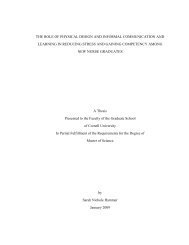The Patient Room: what is the ideal solution? - Cornell University
The Patient Room: what is the ideal solution? - Cornell University
The Patient Room: what is the ideal solution? - Cornell University
Create successful ePaper yourself
Turn your PDF publications into a flip-book with our unique Google optimized e-Paper software.
Executive Summary<br />
DEA 4530/6530<br />
Planning and Managing <strong>the</strong> Workplace: Evidence-Based Design and <strong>the</strong> Organizational Ecology of Healthcare Environments<br />
Design Dilemma Project<br />
Course Description:<br />
Th<strong>is</strong> course examines how <strong>the</strong> physical design of <strong>the</strong> hospital, in combination with o<strong>the</strong>r social, organizational and technological<br />
factors, affects quality of care and <strong>the</strong> experience of patients and care providers. Through a combination of lectures, reading, site<br />
v<strong>is</strong>its, projects and workshops students examine <strong>the</strong> role of Evidence-Based Design (EBD), and <strong>the</strong> associated key <strong>is</strong>sues and<br />
challenges in <strong>the</strong> planning, design and management of healthcare facilities (DEA6530 Syllabus).<br />
Project Description:<br />
Th<strong>is</strong> report will focus on <strong>the</strong> Design Dilemma project specifically. A “design dilemma” <strong>is</strong> a critical design dec<strong>is</strong>ion faced by planners<br />
and designers in an actual hospital project for which <strong>the</strong>re <strong>is</strong> no clear, obvious <strong>solution</strong>. In th<strong>is</strong> project we will explore <strong>the</strong> complex<br />
web of interdependent system factors, <strong>is</strong>sues and stakeholders that need to be considered in planning, designing, and operating a<br />
Med/Surg nursing unit (DEA6530 Syllabus). Each student has chosen a topic or sub-system of interest and we have chosen patient<br />
rooms. <strong>The</strong> report will briefly d<strong>is</strong>cuss <strong>the</strong> h<strong>is</strong>tory of <strong>the</strong> typical patient room on a typical Med/Surg unit and <strong>the</strong>n move into <strong>what</strong> <strong>is</strong><br />
being done today and more specifically how th<strong>is</strong> relates to infection control, <strong>what</strong> role a single-occupancy room plays compared with<br />
double, and <strong>what</strong> evidence-based design <strong>is</strong> used to explore th<strong>is</strong> topic. While we realize how immensely complex <strong>the</strong> patient room<br />
subsystem <strong>is</strong> we can only focus on so many facets in a sat<strong>is</strong>factory amount of depth so <strong>the</strong> aforementioned topics will be d<strong>is</strong>cussed.<br />
<strong>The</strong>se few topics were specifically picked because <strong>the</strong>y represent some of <strong>the</strong> biggest problem areas and places where we see room<br />
for significant improvement. Through research from health information organizations, academic research sources, and specific case<br />
studies we will evaluate <strong>the</strong> effectiveness of standard practice of today and seek new and innovative ways to improve upon <strong>the</strong><br />
norm. Personal observations from site v<strong>is</strong>its, class d<strong>is</strong>cussions, and experience in <strong>the</strong> field will be incorporated wherever possible.<br />
Main Findings:<br />
Available evidence states that although <strong>the</strong>re <strong>is</strong> still great debate over <strong>the</strong> single vs.multi-patient room, single-patient rooms are<br />
extremely helpful in improving patient outcomes. In regards to staff efficiency and patient safety, comfort and sat<strong>is</strong>faction, <strong>the</strong> singlepatient<br />
room <strong>is</strong> superior to a multii-patient room given features such as v<strong>is</strong>ual and auditory privacy, accommodations for family, and<br />
features that allow staff to communicate more with patient, while performing less errors. Evidence-based design <strong>is</strong> ano<strong>the</strong>r<br />
component recently incorporated into <strong>the</strong> patient room that has seemingly a positive effect on patient/staff well being through interior<br />
fin<strong>is</strong>hes that improve patient restoration. However both single-patient rooms and evidence based design continue to be highly<br />
debatable given <strong>the</strong> inconclusive evidence from relevant research and <strong>the</strong> high cots <strong>the</strong>y pose for <strong>the</strong> hospital. In addition to <strong>the</strong><br />
amount of patients per room, compliance with things such as hand washing can be altered by several different factors. Some<br />
specific studies references include sink and/or alcohol d<strong>is</strong>penser locations within <strong>the</strong> room. We also see that clinicians believe <strong>the</strong><br />
use of single-patient rooms <strong>is</strong> beneficial <strong>is</strong> reducing <strong>the</strong> spread of infection and increasing patient safety.







